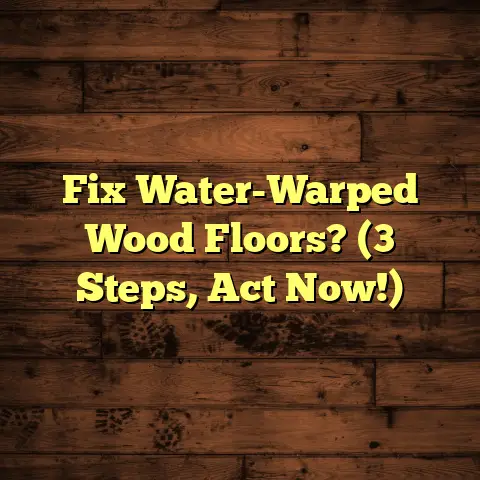How To Apply Poly To Wood Floors?
I remember the first time I finished applying poly to a wood floor. The smell of the varnish filled the air, and as I stood back to admire my work, I felt a rush of pride. The warm glow of the newly finished surface sparkled under the light, transforming the room into a cozy haven. But getting to that moment wasn’t easy; it involved a lot of preparation, trial and error, and attention to detail.
Applying polyurethane to wood floors can seem like a daunting task, but with the right approach, it’s entirely manageable. Here’s a detailed guide based on my experiences, filled with practical tips and insights that can help you achieve that beautiful finish.
Preparing for the Project
Before jumping into the actual application, preparation is key. I always start by assessing the condition of the floor. Is it raw wood, or has it been previously finished? This will determine the steps I take next.
Tools and Materials Needed
Before beginning any project, having the right tools is crucial. Here’s a comprehensive list of what I typically need:
- Polyurethane: Choose between oil-based or water-based poly.
- Sandpaper: Different grits (80, 120, and 220) are essential for smoothing the surface.
- Sanding Sponge: Useful for corners and edges.
- Tack Cloth: To remove dust after sanding.
- Brushes or Rollers: High-quality brushes for oil-based and foam rollers for water-based options.
- Paint Tray: For easy application.
- Drop Cloths: To protect adjacent areas from spills.
- Masking Tape: Useful for protecting baseboards and other surfaces.
Cost Estimation
When I first started out, estimating costs was a challenge. That’s when I began using FloorTally. The platform helps me pull local material and labor rates, making it easier to give my clients realistic budgets right from the start. For example, if I need to purchase poly and other supplies, FloorTally breaks it down, so I know how much I’m spending on materials versus labor.
In my experience, budgeting for a flooring project typically involves several components:
- Materials: The cost of polyurethane can vary widely. For instance, a gallon of oil-based poly might range from $30 to $60, while water-based options can be slightly more expensive. A gallon usually covers about 400 square feet with one coat.
- Labor: If I’m working with a crew, labor costs can add up quickly. Depending on the region, skilled labor might range from $25 to $50 per hour.
- Additional Supplies: Don’t forget about sandpaper, brushes, and cleaning supplies, which can add another $50 to $100 to the total cost.
By utilizing FloorTally, I can provide clients with a comprehensive estimate that includes all these factors, ensuring transparency and trust from the get-go.
Steps to Apply Polyurethane
1. Surface Preparation
The first step in applying poly is to prepare the surface properly. If your wood floor has old finish or damage, start by sanding it down.
Assessing the Condition of the Floor
Before any work begins, I carefully inspect the floor for scratches, dents, or uneven areas. If there are significant imperfections, I may need to consider filling them with a wood filler before proceeding.
Sanding
I usually begin with 80-grit sandpaper to remove any old finish. After that, I switch to 120-grit to smooth out the surface. Finally, I finish with 220-grit for a silky-smooth feel. It’s essential to sand in the direction of the grain to avoid scratches.
Here’s a tip: When sanding large areas, I often use a floor sander for efficiency. However, for edges and corners, I stick to manual sanding with a sanding sponge or hand-held sandpaper.
2. Cleaning
Once sanding is complete, I take a damp cloth or tack cloth to wipe down the floor. This part is crucial because any dust left behind can ruin the finish.
Vacuuming
Sometimes I even vacuum the area after wiping it down to ensure that no particles remain. A clean surface helps ensure that the poly adheres properly and results in a flawless finish.
3. Choosing Polyurethane
I’ve used both oil-based and water-based polyurethanes throughout my career. Each has its advantages:
- Oil-Based Polyurethane: Tends to provide a richer color and is more durable against scratches and wear. However, it takes longer to dry (usually around 8-12 hours) and has strong fumes.
- Water-Based Polyurethane: Dries quickly (about 2-4 hours) and has less odor, making it more user-friendly in enclosed spaces. However, it may require more coats for similar durability compared to oil-based options.
Choosing between them often comes down to personal preference and project requirements. For example, if I’m working on a high-traffic area like a living room or hallway, oil-based poly might be my go-to due to its durability.
4. Application Process
Now comes the fun part—applying the poly!
- First Coat: Using a high-quality brush or roller, I apply the first coat in a thin layer. If I’m using oil-based poly, I make sure to apply it in long strokes along the grain of the wood. For water-based poly, I prefer using foam rollers for an even application.
- Drying Time: Depending on what type of poly I’m using, drying times can vary. Oil-based poly typically takes 8-12 hours to dry, while water-based can be ready in about 2-4 hours.
5. Sanding Between Coats
After the first coat dries, I lightly sand the surface again with 220-grit sandpaper. This step helps ensure that subsequent coats adhere properly. Cleaning off any dust afterward is just as important.
6. Applying Additional Coats
I usually apply at least three coats of polyurethane for optimal durability. The process of applying, drying, sanding, and cleaning repeats with each coat.
Here’s how I structure my application:
- First coat applied.
- Wait for drying time.
- Lightly sand with 220-grit.
- Clean thoroughly.
- Apply second coat.
- Repeat until desired finish is achieved.
7. Final Touches
Once I’ve applied all coats and allowed them to cure properly (usually at least 24 hours after the final coat), I take a final look at the floor. If everything looks good, it’s time for some maintenance tips.
Maintenance Tips
Maintaining a newly finished floor is crucial for longevity. Here are a few tips based on my experiences:
- Keep It Clean: Regularly sweep or vacuum to avoid scratches and dirt buildup.
- Avoid Water: Use a damp mop instead of soaking the floor; excessive moisture can damage the finish over time.
- Use Felt Pads: Placing these under furniture can prevent scratches and dents from heavy objects.
- Reapply Polyurethane: Depending on foot traffic and wear, consider reapplying a coat of poly every few years to maintain its luster.
Challenges Encountered
Throughout my years in flooring, I’ve faced challenges like uneven surfaces or weather conditions affecting drying times. Early on, I learned that humidity can impact how poly cures; in humid weather, I’d sometimes wait longer between coats.
Dealing with Dust Particles
One challenge that stands out was dealing with dust particles settling on wet finish. One time, after applying the second coat in an excited rush, I left the room only to return and find tiny debris all over the surface! It was frustrating having to sand down an entire section because of those little nuisances that marred an otherwise perfect finish.
Environmental Factors
Another issue I’ve encountered is temperature fluctuations affecting drying times and finish quality. On one occasion during summer heatwaves, the rapid drying led to issues like bubbling in oil-based finishes if not applied carefully.
Comparing Approaches
I’ve experimented with different application methods over the years—using brushes versus rollers for example. While brushes give me more control and can reach into corners better than rollers can; rollers allow for quicker coverage on larger areas without sacrificing quality.
Ultimately, the choice often comes down to personal preference and project size. For smaller rooms or detailed work where precision matters most—like intricate patterns—I stick with a brush for its control; while for larger spaces such as living rooms or halls; rollers save time significantly while still delivering a quality finish.
Specialized Techniques for Unique Finishes
Over time, I’ve also experimented with various techniques beyond standard applications—like applying stains before poly or using specialized products for unique effects.
Staining Before Polyurethane
In some projects where clients wanted added character or richness in their wood floors—staining before applying poly was essential! This process requires:
- Choosing The Right Stain: Whether water or oil-based; matching it with desired outcomes plays an essential role in achieving aesthetics.
- Application Method: Using rags or brushes; this ensures even coverage without leaving streaks behind.
- Drying Time Considerations: After staining; allow sufficient drying time before beginning polyurethane application—otherwise risks smudging could occur!
Specialty Products for Unique Effects
I’ve also explored specialty products designed for unique finishes—like satin versus gloss finishes depending on desired aesthetics! Satin finishes provide softer looks while gloss options amplify sheen levels—both affecting perceptions of space!
Troubleshooting Common Problems
Despite all efforts; sometimes issues arise during projects—so here’s how I troubleshoot common problems encountered during polyurethane applications:
Bubbling Finish
If bubbles appear during drying; this often results from applying too thickly or working under humid conditions—you may need to re-sand affected areas lightly before reapplying poly in thin layers!
Peeling Finish
Peeling finishes usually indicate poor surface preparation beforehand! Sanding thoroughly prior ensures proper adhesion—if peeling occurs; removing affected areas entirely may be necessary before reapplication!
Uneven Coating
Uneven coating could result from inconsistent application techniques! Ensuring brush strokes remain consistent along grains helps mitigate this risk significantly!
Real-Life Examples from My Experience
As someone who’s been in this business a long time—I have numerous stories illustrating triumphs (and tribulations) faced while applying polyurethane finishes!
The Living Room Transformation
One memorable project involved transforming an old living room floor—a blend of oak planks that had seen better days! After sanding down rough spots; I opted for an oil-based polyurethane due its superior durability against heavy foot traffic expected post-renovation!
The end result was stunning—a rich amber tone emerged shining brightly under natural light streaming through windows! Clients were thrilled with transformation—emphasizing how much warmer environment felt simply due attention paid during finish application process!
A DIY Nightmare Turned Success
Another story worth sharing revolves around assisting a DIY enthusiast who attempted applying water-based polyurethane themselves but struggled with bubbles throughout!
After assessing situation; we decided together that lightly sanding down affected areas followed by more careful second attempt would yield better results! Patience paid off—as final outcome exceeded their expectations dramatically!
Advanced Techniques and Innovations
As technology evolves; so too do techniques available today! Some advanced methods worth exploring include:
Spray Application Method
Using spray guns allows achieving smoother finishes across larger surfaces quickly—while maintaining control over coverage levels! This method requires some practice but yields professional-grade results when executed correctly!
UV-cured Polyurethanes
These innovative products offer rapid curing times utilizing ultraviolet light! Though typically more expensive upfront; they minimize downtime significantly making them worth considering especially within commercial settings where fast turnaround matters most!
Conclusion
Applying polyurethane to wood floors can be a rewarding experience when approached correctly! With careful preparation & attention-to-detail—you can achieve stunning finishes enhancing your home’s beauty!
Whether you’re a seasoned contractor like me or a DIY enthusiast looking to spruce up your space—these tips will help you navigate process smoothly! Remember each project teaches something new—be patient & embrace journey along way!
Incorporating specialized techniques alongside tried-and-true methods help elevate results beyond expectations—ensuring satisfaction both personally & professionally as well!





